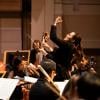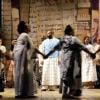
It’s good to know that during these troubled and tumultuous times, Mozart lives. Indeed, in a new production directed by filmmaker James Gray and presented by Los Angeles Opera, The Marriage of Figaro, which premiered in 1786, still features those grand operatic themes of envy, duplicity, and absolution. And lest we forget, there’s also lust and vulnerability, all wrapped up with a luscious comedic/satiric bow.
Seen at the Dorothy Chandler Pavilion on Saturday night, with five additional performances through Feb. 26, Figaro is based on the play by Pierre Augustin Caron de Beaumarchais, and its story is a doozy, set in motion by the “droit du seigneur,” the supposed right of a feudal lord to deflower a vassal’s bride on their wedding night. Within that framework, then, there’s a lot of antic madness in the tale of two weddings: Figaro, steward to the philandering Count Almaviva, is betrothed to Susanna, maid to the morally upright Countess Rosina; and Marcellina, Dr. Bartolo’s housekeeper, ends up doing the marital thing with her employer.

Throw into the mix an orphaned Figaro, who finally learns the identities of his biological parents; a spry and uber-hormonal Cherubino, the Count’s young page boy who can’t help falling in love with every woman he sees; and Barbarina, daughter of the aristocrat’s boozy gardener Antonio. The melodious menagerie also includes the snooping music teacher Don Basilio, while plot devices like a love letter, a missing brooch, and characters hiding to overhear things or avoid discovery keep the comic misunderstandings on the boil.
That said, Figaro, with its sexual machinations, class struggles, and a kind of faux gender reveal, would be nothing without fine singers. Happily, this production delivered in spades. Figaro was deftly sung by agile bass-baritone Craig Colclough; silky-timbred soprano Janai Brugger, as the strong-willed and intellectually superior Susanna, also proved appealing, especially in her emotional account of “Deh vieni, non tardar” (Come, do not delay).
Plush-voiced soprano Ana María Martínez, as Rosina, paired with Brugger for the sumptuous duet “Sull’aria” (On the gentle breeze) and mesmerized with her soulful arias, “Porgi amor” (Come, love) and “Dove sono i bei momenti” (Where are they, the beautiful moments).

The delectable pants role of Cherubino, gorgeously sung by mezzo-soprano Rihab Chaieb in her LA Opera debut, prompts the question, what are their pronouns? For a character whose philandering ways land him in sticky situations, Chaieb’s Cherubino soared in “Non so più” (I don’t know, anymore, what I am), crisp enunciation and commitment on full display. This musical bauble may very well be an existential question that many, no matter gender, can relate to. Chaieb’s physicality and general cavorting added to the show’s insouciance.
Also in stellar voice and with acting chops to burn: Grammy Award-winning baritone Lucas Meachem, a near regular at LAO. Whether in enticement, ravenous, or contrition mode, his hearty-voiced Count captivated throughout. Bass Kristinn Sigmundsson added comic piquancy as Bartolo in his showpiece aria “La vendetta” (Revenge) and was partnered by the formidable soprano Marie McLaughlin as Marcellina, who paraded around with requisite sass and pomp. Tenor Rodell Aure Rosel as Basilio engaged with lyrical flair. In supporting roles, mezzo-soprano Deepa Johnny as Barbarina, tenor Anthony León as Don Curzio, and bass-baritone Alan Williams as Antonio invigorated this Mozart masterpiece.
Director James Gray’s operatic debut did not disappoint, and he kept things moving at a brisk pace, balancing the work’s comedy and dramatic tension in near equal measure.

The costumes were yet another wellspring of delight. Made by famed couturier Christian Lacroix, the garb was, for the most part, traditional, although for Figaro and the choristers playing peasants, the attire was said to be inspired by Spanish artist Francisco Goya’s early 19th-century paintings. The apparel, constructed with unique fabrics and trim and sourced from French markets and antique collections, made the production positively pop. The fluid yet serviceable sets, including a boudoir, a palm tree-adorned garden, and a chandelier-festooned ballroom, were designed by Santo Loquasto, with lighting by York Kennedy.
Keeping the engine tuned and on track was James Conlon, LAO’s superb music director. Delivering clarity, steadiness, and oomph from the pit, with harpsichordist Kevin Murphy showcased as well, Conlon also knew when to take a breath, infusing the score with hyperacuity. He and the orchestra provided the perfect accompaniment to the opera he called in his program note a battle of the sexes, with “the women, more evolved, bring[ing] sense and humanity into the world of prerevolutionary France.” The flower-festooned LA Opera Chorus, directed by Jeremy Frank, were in fine form.
And what’s an opera buffa without a little terpsichorean spirit, here created by choreographer Kitty McNamee in the form of a quasi-balletic dance. A blink-and-you-miss-them quartet of dancers made the most of their brief time in the spotlight, their leaps and high kicks a jubilant show of athleticism.
Another feather in LAO’s cap, this Figaro, a co-production with, among others, the Théâtre des Champs-Élysées, is a multilevel lovefest — simply put, a great night in the theater.




